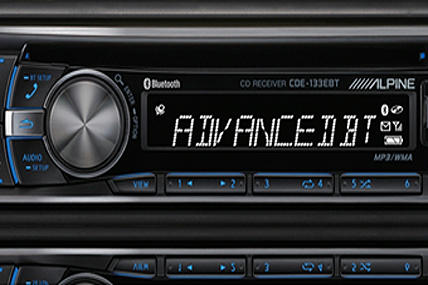The latest and greatest features are the ones that you will have to spend extra money on, so you need to decide if they're worth the dough. Usually such features start to trickle down to less expensive head units as the years go by, until they eventually become standard across a manufacturer's line.
Bluetooth
Bluetooth technology allows you to use a mobile phone hands-free. A compatible phone syncs with the head unit, and when a call comes in, it's automatically answered and the audio system is muted. The caller's voice is broadcast over the car's speakers and your voice is picked up by a small microphone inconspicuously installed in the vehicle. When the call is over, the audio system resumes. Bluetooth's Advance Audio Distribution Profile (A2DP), found in the newest head units, also allows streaming music from compatible mobile phones, PDAs, and MP3 players. See Chapter 8 for more on Bluetooth.
HD Radio
HD Radio offers digital-quality sound and multicasting, meaning that stations can broadcast alternative and largely commercial-free programming on sub-frequencies. You'll need an optional tuner to receive it.
SD Card Slot
Some radios allow access to tunes via an SD Card, which, depending on their size, can hold as many as hundreds of MP3 music files.
Inspecting the Specs
When shopping for a head unit, you should also look at certain specs, if they're listed, to compare performance among the various products you're interested in. Although car audio manufacturers are not required to publish specifications and they can even massage specs to make them look perhaps better than they really are, just the fact that a manufacturer goes to the trouble to provide some of the more esoteric specs says something about their reputation - and the worthiness of the specs.
Below are some of the most important head unit specs to scope out. Although not all head unit manufacturers list all of the specs listed here, look for the ones that are most important to you. For example, if radio reception is a paramount concern, zero in on a head unit's tuner specs.
- Amplifier power rating is the amount of power a head unit's amplifier is able to produce, such as 16 watts x 4. But it should be accompanied by impedance, supply power, and distortion specs, such as 16 watts x 4, into 4 ohms (impedance) @ 14.4 volts (supply power) with 1% total harmonic distortion (THD).
- Signal to noise ratio refers to the strength of a head unit's output signal relative to the level of noise present and is measured in decibels (dB). A higher number is better.
- Total Harmonic Distortion (THD) refers to the amount of distortion in the audio signal generated by a head unit. The lower the number, the better.
- Dynamic range refers to the ratio of maximum to minimum loudness in an audio signal. The higher the number, the better.
- Frequency response refers to the frequency range a head unit is able to reproduce, such as 5 to 20,000 Hz, +/- 1 dB. In this example, the head unit can reproduce frequencies between 5 and 20,000 Hz, with a tolerance, or margin of error, of plus or minus 1 dB. The wider the frequency range is, the better, and the narrower the tolerance, the better.
- Channel separation refers to an AM/FM tuner's ability to eliminate crosstalk or leakage between radio stations that are in close proximity on the dial. Crosstalk refers to a station on one frequency leaking into the frequency that another station occupies. The higher the number, the better.
- Capture ratio refers to the ability of an AM/FM tuner to distinguish between a stronger station and a weaker station occupying the same frequency. The higher the number, the better.
- Alternate channel selectivity is a measurement of a tuner's ability to reject an interfering signal. The higher the number, the better.
Installing Your Head Unit
Installing a head unit in a dash isn't what it used to be. Back in the day, swapping a stock head unit for an aftermarket one was pretty straightforward. But both cars and head units have gotten far more sophisticated in the last decade or so. And while the basics of installing a head unit haven't drastically changed, there are many more things involved these days.
Modern cars can be very complex. Many have safety features such as ABS brakes and advanced airbags that were uncommon just a few years ago, and even some economy cars now include sophisticated onboard computers and electronics. Plus, factory head units are often tied into other systems in a vehicle, such as climate controls, navigation, and onboard diagnostics. One false move with a pair of wire cutters or a screwdriver, and you could be looking at thousands of dollars in damage. Head units are far more sophisticated as well. Although a simple CD radio is pretty straightforward to install, Bluetooth head units and multimedia DVD head units with navigation and a video monitor require additional wiring. One false move and you could fry your new head unit.
Most stock radios are a standard shape, either DIN (2 inches high x 7 inches wide) or double DIN (4 inches high x 7 inches wide) and some instances DIN-and-a-half sized (3 inches high x 7 inches wide). If you have an odd-shaped radio, however, such as those in some Nissan and Infiniti vehicles, you should seriously consider having a professional install your head unit.
If you've thought about it and still feel confident proceeding with a do-it-yourself job, there are some rather basics steps required in any head unit installation. First, it's always a good idea to disconnect the battery when working on any electrical components in a vehicle. Simply disconnect the ground lead from the battery. If you have an aftermarket alarm system, sometimes you'll need to reset the alarm when the battery is reconnected. On some higher-end cars, the dealer may need to reset the computer when power is restored.
Removing the Stock Radio
Before you begin an installation, the stock head unit must first be removed. To do this, you may have to remove the trim around the radio. Carefully pull or pry off the trim. Most stock radios are secured with three or four bolts, and some European cars require a special "key" to remove the radio, which you can purchase from the dealer or online. After detaching the radio, slide it out through the front of the radio opening.
A factory radio is usually connected to the factory wiring with a plug called a Molex connector, shown in Figure 10-1. Disconnect this plug and the stock head unit should be home free. If you plan on keeping your factory radio, remember that some require a code to work properly when you plug it back in. Make sure you have it or ask your dealer for it before you remove the stock radio.
From Car Audio for Dummies, copyright © 2008 by John Wiley & Sons, Inc., Hoboken, New Jersey. Used by arrangement with John Wiley & Sons, Inc.











